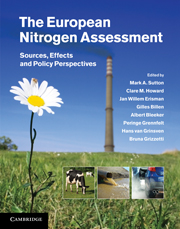Book contents
- Frontmatter
- Contents
- List of contributors
- Foreword
- Summary for policy makers
- Technical summary
- 1 Assessing our nitrogen inheritance
- Part I Nitrogen in Europe: the present position
- Part II Nitrogen processing in the biosphere
- Part III Nitrogen flows and fate at multiple spatial scales
- 10 Nitrogen flows in farming systems across Europe
- 11 Nitrogen flows and fate in rural landscapes
- 12 Nitrogen flows and fate in urban landscapes
- 13 Nitrogen flows from European regional watersheds to coastal marine waters
- 14 Atmospheric transport and deposition of reactive nitrogen in Europe
- 15 Geographical variation in terrestrial nitrogen budgets across Europe
- 16 Integrating nitrogen fluxes at the European scale
- Part IV Managing nitrogen in relation to key societal threats
- Part V European nitrogen policies and future challenges
- Glossary
- Index
- References
10 - Nitrogen flows in farming systems across Europe
from Part III - Nitrogen flows and fate at multiple spatial scales
Published online by Cambridge University Press: 16 May 2011
- Frontmatter
- Contents
- List of contributors
- Foreword
- Summary for policy makers
- Technical summary
- 1 Assessing our nitrogen inheritance
- Part I Nitrogen in Europe: the present position
- Part II Nitrogen processing in the biosphere
- Part III Nitrogen flows and fate at multiple spatial scales
- 10 Nitrogen flows in farming systems across Europe
- 11 Nitrogen flows and fate in rural landscapes
- 12 Nitrogen flows and fate in urban landscapes
- 13 Nitrogen flows from European regional watersheds to coastal marine waters
- 14 Atmospheric transport and deposition of reactive nitrogen in Europe
- 15 Geographical variation in terrestrial nitrogen budgets across Europe
- 16 Integrating nitrogen fluxes at the European scale
- Part IV Managing nitrogen in relation to key societal threats
- Part V European nitrogen policies and future challenges
- Glossary
- Index
- References
Summary
Executive summary
Nature of the problem
Farms represent operational units which determine N-use efficiency and incorporation into products and, collectively, at the wider scale, determine the extent of environmental losses from agriculture.
The basic principles and objectives of using N, from whatever source, pertain to different systems across the wide range of farming types across Europe.
In addition to managing external inputs (fertilisers), there is much opportunity to improve N transfers within the farm. Mineral fertilisers are added to balance supply/demand for crops. Some systems rely on legume-N which, once incorporated into farm cycles, behaves in the same way as other N forms.
Approaches
Farm N cycles, their constituent parts and controlling influences are described and generalised principles identified.
Farm budgets for a range of systems, focussing on typical practice in NW Europe are shown which illustrate some general, important differences between farming systems.
Key findings/state of knowledge
Benefits of using N effectively are far reaching with immediate impact in promoting production. Use of N also provides an effective and flexible management tool for farmers.
Crop N requirements are determined from response curves and economic optima. Advice is supplied to farmers from various sources but the extent to which it is taken depends on many factors. New technologies are available to improve N-use efficiency. The basis of good N management is to optimise efficiency of added and soil N by increasing the temporal and spatial coincidence between availability and uptake of N.
[…]
- Type
- Chapter
- Information
- The European Nitrogen AssessmentSources, Effects and Policy Perspectives, pp. 211 - 228Publisher: Cambridge University PressPrint publication year: 2011
References
- 18
- Cited by

